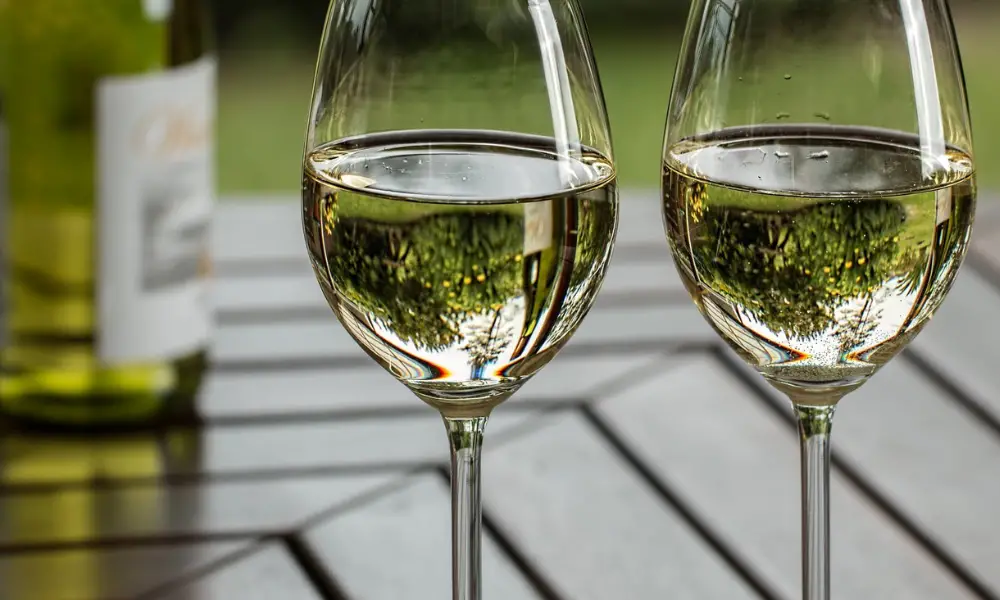If a white wine is kept in the refrigerator, its natural flavors are lost. White wine can be kept in the refrigerator for about 5-7 days. However, unopened white wine lasts far longer. While sparkling wines have a significantly smaller window of enjoyment.
While red wine must be served warm, white wines can and should be served cold. However, they shouldn’t be kept so cold that it mutes the scents. White wine should be cooled between 45 and 55 °F (8 and 12 °C). White sparkling wines and sweet white wines ought to be in the cooler end of that range.

How to Store White Wine?
White wine should be stored at a temperature of 55°F. The same is true for a few degrees up or down from that. Once more, provided that the storage temperature is stable.
Is this thing truly this easy? Yes, it most certainly can! Although certain wines would benefit from storage at 53 or 54 degrees and others from 56 or 57 degrees, the difference is minimal.
A stable, non-destructive environment that shields wine from severe and unstable temperatures is essential for successful wine storage. The difference of a few degrees is not particularly significant.
How Long Does Wine Last?
Champagne and sparkling wine survive roughly six months in the pantry, while red and white wines can be left unopened for up to a year. And how long does wine remain potent after opening a bottle? According to Andrea Robinson, a master sommelier and the author of Great Wine Made Simple, white wines, such as rieslings and sauvignon blanc, have an acid that helps keep them fresh after being opened for around three days. In contrast, most red wines should be consumed within a day or two. In contrast, the refrigerator keeps only champagne and sparkling wine for one day.
According to Michael Aaron, chairman of Sherry-Lehmann Wines & Spirits in New York City, you should use a tool like a Rabbit vacuum pump to remove as much air as you can from opened bottles of wine to extend their shelf life to around a week. Moistening the stopper first will ensure the tightest seal.
How to Store Unopened Wine?
Lay Bottles Sideways
Most wine bottles still come with natural corks, even if some have screw-on tops or rubber or synthetic corks that can withstand standing up. According to Robinson, a natural cork must remain moist and stretched to maintain an airtight seal that protects the wine from oxygen and outside odors. So that the cork keeps in constant touch with the wine, store the bottle on its side.
Pick a Dark Location
According to Robinson, a wine that has been “light struck” has been exposed to bright light for a lengthy period and will taste “numb and dumb.” There is still a risk of exposure even though most bottles are made of tinted glass, which provides some UV protection. According to Anita LaRaia, author of Pick a Perfect Wine In No Time, the most crucial step is to keep the bottles out of direct sunlight. Keep it low to the ground or in a cabinet to protect your wine from overhead fluorescent lighting, which can also harm it.
Keep it Stable if You can’t Keep it Cool.
Unopened wine does not require refrigeration. White wine should be stored at 45°F and red wine at 55°F; however, if the bottle will be opened within six months, a warmer room temperature is acceptable. Just keep bottles away from hot spots and places with extreme temperature swings, like right next to the stove or dishwasher. Robinson advises against keeping a collection on top of the refrigerator. The heat from the refrigerator exhaust and overhead lighting is intense, and the frequent tremor can harm the taste.
How to Store Opened Wine?
Re-Cork immediately
Keep the bottle closed if you know you won’t drink all of it. According to Hoel, your first line of defense for keeping your wine fresh is to immediately re-cork the bottle after each drink. The expert adds that it keeps the flavor of your wine fresher for longer by limiting the amount of air that comes into touch with it.
Another suggestion is to place the cork with the same end in the bottle (the other end has been exposed to mold and odors). If the cork won’t go in smoothly, use the blade of a corkscrew to cut a notch towards the bottom on either side or get an inexpensive, reusable rubber stopper from a wine shop.
Keep the Bottle Cold
Like all other wines, red wines survive longer if they are kept refrigerated after opening. Hoel advises storing open wine bottles below room temperature and out of direct sunlight. “The best location to store wine is frequently the refrigerator, which can help keep it fresh. As a result of the molecules traveling very slowly, the oxidation of the wine is slowed down.”
Why does Wine Storage Temperature Matter?
Ideal storage conditions promote the desired chemical reactions in wine. When temperatures are too high or low, molecules start to slow down, disintegrate, or undergo other changes. Due to this, wine storage temperature is important.
Nothing less than safeguarding the character and longevity of your wine is at stake. Some of the best wine books contain a tonne of information on different wine varieties.
Long-Term Wine Storage Temperature
Red wines should be kept in a steady temperature range between 53°F and 57°F if you intend to keep them for many years (or decades).
Wine may age too quickly at temperatures above 57°F, while improper flavor development may be prevented at temperatures below 53°F. Here is more information on aged wines.
Wine dead stock occurs so quickly because of this. You can say goodbye to your wines if you store them improperly.
Short-Term Wine Storage Temperature
Nowadays, most wines made and bought are meant to be drunk as quickly as possible. Consequently, you can arrange for storage.
The consensus among wine lovers and students at all sommelier levels is that you should store a bottle of wine at its ideal serving temperature if you want to keep it for fewer than six months before drinking it.
Using a wine inventory sheet, you can keep track of your liquor inventory and ensure your wines are cellared for the right amount of time. So, the game has begun. It’s bad not to keep wine at the recommended temperature for storage. So let’s make a difference.
How is White Wine Supposed to be Stored?
Unopened bottles of white wine should be kept in a cold, dark location, such as a cellar or internal closet, where the temperature remains constant between 45 and 65 °F. The ideal environment to store the bottle in until you’re ready to consume it is one with a humidity level of 50 to 75 percent.
How Long Can White Wine Stay in the Fridge?
5-7 days with a cork in the fridge when kept in your refrigerator, most light white and rosé wines will stay palatable for up to a week. After the first day, you’ll notice a subtle shift in flavor as the wine oxidizes. Often, the wine’s overall fruit quality will wane and become less vivid.
Is it Necessary to Keep an Unopened Wine Fridge?
Maintaining a stored wine at a constant temperature for as long as possible is preferable if you’re talking about keeping it refrigerated while storing it. When served at room temperature, a chilled wine will most likely reheat up if you’re wondering about serving it chilled.
Can I Drink Opened Wine After a Month?
Yes. Old opened wine can be consumed without harm as long as no harmful microorganisms are present. Even if the wine appears to have mold, drinking it won’t make you sick (unlike with spoiled food, for example.) However, cork taint or ruined wine won’t have a good flavor or scent and may taste strange.
Is White Wine Good for Plants?
Because wine contains nitrogen, it’s an excellent addition to your compost pile. Although it might seem counterintuitive, you can fertilize your plants with leftover wine. White wine is a type of wine that undergoes skin-free fermentation. It is created through the alcoholic fermentation of grapes with any color of skin but no color in the pulp. Straw yellow, yellow-green, or yellow-gold are all acceptable hues.
Can White Wine Make You Gain Weight?
Overindulging in wine can result in weight gain because you’ll take in more calories than you expend. Additionally, alcohol calories are often considered empty because most alcoholic beverages do not include significant amounts of vitamins, minerals, or other nutrients.
Conclusion
The primary flavor component of wine is its fragrance. The scent of a wine is also influenced by its temperature. Sniffing a bottle after removing it from the refrigerator will allow you to determine its temperature. You will likely detect alcohol in cold wines and their cool aroma and flavor. A wine served at the proper temperature will produce delicious flavors and aromas.
